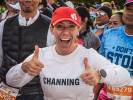How to train for a road race
By KIMBERLEY MCGEE
VIEW ON HEALTH
One particularly cold winter morning last year, unable to swiftly get out of bed, Jim Lewellyn made a promise to himself.
"From a pack a day to a mile a day in six weeks," Lewellyn, a former Marine, smoker and weekend hockey player, said. "I'd never run a day in my life, but I woke up that morning hacking and coughing up a lung and knew I had to trade my (Marlboro) reds for running shoes."
The 56-year-old mechanic and charismatic car salesman didn't fall back to bed or even tell his wife, Suzette, his plans to turn over a new leaf last February.
"He started taking off down the street one, two, three days in a row instead of sitting in front of the TV with the paper," Suzette Lewellyn said. "I didn't think much of it until two weeks later there wasn't that smell of smoke in the house, and there was money in a jar."
Jim Lewellyn started putting the money he had earmarked for cigarettes in a clear pickle jar near the garage door after he began to realize his exercise routine was making a permanent change to his waistline. He used that money to buy a book on training for a marathon that his son, James, had recommended two years earlier.
"It took me a while, but I was feeling better, and I thought I could finally do it, quit (smoking)," he said. "Every time I looked at that jar and saw the dollar bills piling up in there, I knew I was making the right decision."
Although he picked up a pack or two of cigarettes over the months, he found smoking wasn't the enjoyable recreation it once was for him.
"I would smoke, and it would take time off of my morning run," he said. "I started to hate that need to smoke."
In October, after losing 25 pounds and running every other day for six months, he ran a road race with his son in Arizona. He wasn't first to cross the finish line, or second or 10th, but he completed his first 5K (5-kilometer road race, or 3.1 miles) in a little over 40 minutes. He hasn't had a cigarette in six months.
"I was proud of myself -- still am," he said. "I hope to run a full marathon next fall, but I'll be doing a lot more 5Ks, and a lot more living, that's for sure."
Running a 5K is something anyone can do, from couch potatoes to occasional fitness fans, said Robert Braden, a chiropractor specializing in sports medicine. Braden is owner of Valley Spine and Sports. His wife, Cindy Braden, a certified personal trainer and leading Las Vegas fitness expert, owns Let's Lose It, a weight loss fitness facility. Both businesses are located at 6823 Ponderosa Way in the Southwest Las Vegas valley.
Physical education and a good physician are two key components to completing a 5K safely, the Bradens agree.
"There's a lot of stuff you can read about (how) to train for a marathon," Braden said. "There are different training techniques people go after when training for a marathon, such as training by heart rate or the volume of the mileage. It depends on what you feel is more important to you and the (good or bad health) you may be in."
The Bradens provide a full fitness training regimen for those looking to run a 5K in 2011.
The half-marathon (13.1 miles), has been the fastest growing road race in the United States over the past decade, according to the Runner's World magazine's annual marathon report. Zappos.com has its annual Las Vegas Rock 'n' Roll marathon and the annual Las Vegas Great Santa Run has become a huge event, drawing runners from around the world. And running isn't a gender-biased sport. Half-marathons are largely run by females at more than 55 percent, up from 20 percent 25 years ago, according to runningusa.org, a non-profit organization for the running industry with USA Track & Field.
Training for a half-marathon doesn't take as much time as a full marathon, which often requires a minimum of four to six months of more intensive workouts to properly prepare.
Many who limp in to Braden's Southwest office start off on the wrong foot. They think that dusting off those old sneakers from the back of the closet, opening the door and running around the block a few times is a rather good start. But they've already made the biggest mistakes any runner can make when beating feet to better health, Braden said.
Someone who is just starting out would benefit from running on a professional track, such as those at the local high school or college. The track offers a bit of cushion for the beginning runner. Concrete and asphalt can be more stressful on joints and soft tissue.
"The impact is better for them than the street or concrete or asphalt," he said. "There are a lot of variables to look at. It sounds complicated, but it's easy. But your body is going to break down when you train, no matter what."
Braden recommends that anyone considering a fitness regimen required to train for a marathon or half-marathon be evaluated by a physician or work closely with a trainer who is accredited in physical fitness. All you need to begin is determination, a good plan, a good doctor and a great pair of running shoes, which have been proven to significantly reduce the impact on your legs and joints while helping to prevent back pain and lower limb injuries.
"Definitely see a sports doctor, someone who understands running issues," he said. "People have things that creep up on them when they start putting mileage on their body by running. It saves a lot of time and aggravation if you have a good sports doctor."
The amount of damage or where the first signs of trouble appear can depend on your personal health history and athletic habits.
"The biggest thing in this is the knee issue and the back," he said. "You really should get evaluated if there is a history there and make sure to get the proper shoe wear."
Good equipment is worth the investment, Braden said. Proper running shoes and clothing that are appropriate and safe can make training for a road race easier, and make the runner more likely to stay with his program and eventually achieve his goal.
"I see so many people who run, or are just beginning to run and who are aging, come in, and they are wearing shoes that are very inappropriate," Braden said. "If someone is preparing for that type of running, training for a marathon, they shouldn't just jump out and do it. They need to get educated, and that's fairly simple to do."
Braden suggests keeping a running journal to be aware of aches and pains, goals and mileage. It allows a runner to be aware of flagging, injuries and motivation. A good 5K shouldn't be about your time either; it should be about getting out there and doing it.
"The biggest issue is to prepare your body for the volume of running you will be doing," Braden said. "The nature of the beast is shock and turnover. We build the patient up and make sure they are strong enough to do the load. Mileage is important."
Someone who hasn't had much physical activity should begin by walking or jog-walking.
"That's a good way to progress," he said.
Regular training is important to maintain a healthy body.
"It's like anything; you have to research and plot your goals to get to the end," he said.
For those starting out, attempt a two month schedule of running. Begin the first week with a brisk walk or jog walk every other day or start out with a two mile run if you've been exercising regularly. Braden recommends keeping to this low-impact schedule for the first week, getting in two miles at the minimum.
"The goal is to increase your weekly mileage by ten percent each week," he said. "So if you start out at two miles each run, and run Monday, Wednesday, Friday, and Sunday, that would be eight miles."
One quotient of the running equation is overdone, Braden said.
"People are over educated on nutrition," he said. "They take everything, things that have really very little scientific basis and research on what is actually working."
He sees people who take too many vitamins, supplements, powders and experimental, over-the-counter pills to get to their end goal faster.
"It doesn't work," he said. And it can be dangerous.
For women runners, he recommends a vitamin with a good mineral content.
"And men take way too much stuff that is not going to enhance their performance," he said.
It's important to replenish protein and be aware of inflammation of joints and take doctor recommended over-the-counter drugs for that to reduce injury.
"There are more natural things to take than (powders or muscle boosters)," he said. "It's simple, too, but people are misinformed. They think if they buy the most expensive shoe and take all sorts of supplements that they are ahead, but then they get frustrated and quit or get frustrated and injured."
Many of the runners Braden sees have found themselves in his office due to impulse. They jump in to running without looking at the casual risks that can be significantly reduced with proper care.
"We see a lot of issues with the lower part of the body, shin splints, the heel," he said. "The body tends to breakdown when you run; that's the biggest thing you see."
Running is tough, which is why people do other cardio work outs if they are trying to lose weight as well as gear up their body for future wellness.
"If people want to run, they should look at everything," Braden said. "It's a great work out, but you should really do it safely."























